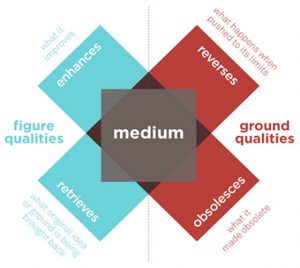The advertising industry is the unacknowledged legislator of wokeness.
Figure: Doom / Ground: Renaissance

A new dark age? Don't believe the hype.
It is always darkest just before the Day dawneth
—Thomas Fuller (1650)
Have you ever heard the term “doomer” (not to be confused with “boomer,” “bloomer,” or “zoomer“)? How about the “black pill” (not to be confused with the “red” and “blue” pills)? Leave it to social media to enrich the English language.
A Rolling Stone article recently landed in my feed—”Teen Suicide Is on the Rise and No One Knows Why.” The subtitle? “A new CDC report reveals that teenage suicide rates have increased exponentially in the past decade.” Nothing, in fact, can grow “exponentially“—limits are embedded in any growth process—but you have to wonder if this “exponential” is somehow linked to the more famous one, often described as “the Singularity.” Might teens be killing themselves at the prospect of being replaced by robots?
A major technology industry conference, Techonomy 2019, drums up support for attendance with an article by its organizer, David Kirkpatrick, titled “What Are the Real Issues We Must Urgently Address?” It is capped by a graphic of collapsed masonry, as if the walls around us are now falling down. Included on this list are what Kirkpatrick calls an “interlinked chain of systemic failures”: Tech platforms that fail to purge hateful, dishonest, deceptive, and manipulative speech (i.e. the same Facebook about which Kirkpatrick wrote his over-the-top book The Facebook Effect), as well as climate change, xenophobia, demagogic populists, and hyper-partisanship. Is this really a promotion for “Doomonomy 2019”?
DC Comics, responsible for much of today’s “blockbuster” entertainment, has a very popular series called “Doomsday Clock”—the “unauthorized sequel” to the earlier “Watchmen” series, created by the “chaos-magician” Alan Moore, which has just (re)launched as a high-budget drama on HBO. Issue 11, the latest, is titled “The End of All Things.” The “Watchmen” are taken from an imaginary “clock” started by the Bulletin of Atomic Scientists in 1947, representing the likelihood of man-made global catastrophe; the earlier series was based on a “watchmaker god,” named Dr. Manhattan. Are computers the new nuclear weapons? At $4.99 a copy, what “kid” wouldn’t want the latest “doomsday” update?
The global giant PR firm Weber Shandwick (part of Interpublic), has released its latest summary of developments with a 32-page report titled “Media Genius.” The cover is dominated by an abstraction which resembles a super-villain from the “illustrated novel” genre. In other times, we would have quickly identified it as a “demon.” Breaking with the typically “glossy” material from this industry, “Media Genius” specifies not just the positives but also the negatives of our new “media environment.” Are the social/personal implications of these new technologies more bad than good? Might they be telling us that we have reached “peak madness”?
Recently, the Vatican sponsored a three-day event called “Common Good in the Digital Era”. Press coverage featured Silicon Valley stalwarts bemoaning their failures and promising to do better despite the fact that, as many have noted, the idea of a “common good” seems very out-of-date in today’s climate. The Vatican also recently hosted a CAPP Foundation event titled “The Catholic Social Teaching from Inception to the Digital Age,” keynoted by climate activist Jeffery Sachs. It seeks to promote “Integral Ecology,” which is Vatican-speak for “environmentalism.” Might they have noticed that this is also a primary vector in today’s shift towards an “ecology of doom”? Extinction Rebellion? Greta Thunberg? As we all know, it’s not many years left before “the end of all things.” Tick-tock (and TikTok).
Figure and Ground
Marshall McLuhan adopted the terminology of figure/ground from his reading of the 1930s Gestalt psychologists. In the margins of many of the books in his personal library, now part of the UNESCO “Memory of the World Register,” he frequently used the shorthand of “f/g.” In his estimation, most people ignore the “ground”, focusing instead on the “figures.” Gestalt agreed. McLuhan protégé Neil Postman summarized this in the title of his 1985 book, Amusing Ourselves to Death: Public Discourse in the Age of Show Business.
Doom is today’s “figure”—with often disastrous results. But what is today’s “ground”?
McLuhan’s understanding of figure/ground was based on the observation that people-in-general actively avoid understanding the world in which they live. There are plenty of bright and shiny objects to “distract” us. Apprehending actual reality can be dangerous (thus “conspiracy theories”). But there is something more fundamental going on. We have been trained to deliberately ignore reality.
“Reality” is a problem for many because the modern media environment (or what McLuhan called the “medium”) is based on illusions. Electric media, beginning with the telegraph, has relied on “make believe” and what some still call the “suspension of disbelief.” Telegraph implies a “sender” who simply isn’t there. Radio just appears from the ether. Movies rely on “flicker fusion” to fool the eyes. Television puts all these together into a witch’s-brew of multi-media illusions. All this illusory bombardment has now turned into accusations about “fake news.” Might this imply that the ground has shifted?
There is also the matter of responsibility. As we understand the ground of our experiences, we recognize our responsibility for its effectiveness. As the comic figure Pogo once suggested (yes, speaking about environmental destruction), “we have met the enemy and he is us.” Or, as Marshall put it in a 1969 letter to Catholic theologian Jacques Maritain, “there is a deep-seated repugnance in the human breast against understanding the processes in which we are involved. Such understanding implies far too great a responsibility for our actions.” No wonder we “amuse ourselves to death”—until it’s not funny anymore.
McLuhan: a Figure Without Ground
McLuhan famously had a difficult time getting his contemporaries to understand what he was talking about. Many accused him of being obscure and confusing. “Global verbalizer,” said geo-political historian Carroll Quigley. Perhaps, as some have suggested, McLuhan was trying to “hide” the basis of his insights. But he was relentless in trying to find people who would help him to get his points across. Nearly all of McLuhan’s books have a co-author. Even his early collaborator Edmund “Ted” Carpenter complained that his name was left off of Understanding Media: The Extensions of Man (1964). Conversely, McLuhan’s most popular book, The Medium is the Massage: An Inventory of Effects (1967), wasn’t even written by him.
What was so hard for him to communicate? McLuhan didn’t have a “new ground” to look forward to. He had nothing positive to say. When asked if he was an optimist or pessimist, he answered “neither, I’m an apocalypsist.” So, even though many, including the cheerleading Whole Earth Catalog, promoted him as a pro-television “guru”, resulting in his stature as “Patron Saint” of the successor publication Wired magazine, anyone paying attention knew that he detested everything about that medium, which he kept in the basement and rarely turned on. All he could describe was what he personally hated. So, he tried to leave himself out of what he wrote. But that didn’t work very well. And the contradiction was never resolved.
Marshall was a man out of his time. He was a Thomist, with the “strict” Thomist Étienne Gilson as his mentor. Gilson’s Pontifical Institute of Medieval Studies was behind McLuhan’s migration to the University of Toronto in 1946. His sensibility—the “media” training which is the bedrock of McLuhan’s work—was “medieval.” As an English professor, he specialized in the “modernists”—who had been anathematized by his Church. He wrote up what he actually thought about them for a Catholic audience, in Renascence, a literary journal still published by Marquette University, but few outside the 2000-issue Catholic library print-circulation ever read those unflattering essays/reviews. This was quite on purpose, because scholars who have taken up McLuhan as a literary critic steadfastly avoid this work. In their minds, it just doesn’t fit.
McLuhan needed a new ground to champion. He needed something that “recovered” the medieval attitudes he cherished. He didn’t live long enough for that to happen. Could today’s turmoil be an answer his prayers?
Renaissance
Recently I visited the Medici Archive Project (MAP) in Florence. I had met those involved in New York and they were generous to let me make an appointment. If there is a “ground zero” for archive-based renaissance research, MAP is probably it. The Warburg Institute in London still does this sort of work, as do others, but MAP has the material that they all need to access. Digitally. For the first time ever.
I asked those running MAP a simple question: Who are the new Medici?
This, not surprisingly, struck them as very odd. Then I suggested that we are now in a new “renaissance” (adding that they seem to occur with some regularity in the West, perhaps not unlike the recognized “cycles” in Chinese culture). They also thought that was odd. Apparently this is not the way they think at the Medici Archive Project.
Instead, I was told that we are today in a “new dark age.” The evidence for which is everywhere to be seen. No, I didn’t bring up figure/ground. No need to insult my hosts. But clearly they had fallen for the figure of “doom.” As have so many other academics. Woe to them.
If doom is the figure, as it clearly is today, then what is the ground? Renaissance is my answer. Digital renaissance.
Marshall McLuhan was frustrated that no one seemed to “get” what he was talking about. “Not scientific” seemed to be the complaint. So, in the 1970s, Marshall set out to rewrite Understanding Media in terms of a “new science.” He had the significant help of his son Eric. The result wasn’t published until 1988, long after Marshall’s death in 1980, with the title Laws of Media: The New Science. Few McLuhan scholars take it seriously. That is, alas, a major mistake.
The McLuhans published a very important Tetrad—the new scientific heuristic of causality they invented—on the “Computer.” Little recognized, or so it seems, it points to exactly where we are today. No, despite what the Internet says, Marshall didn’t “predict the Internet.” But he did anticipate our new digital environment.
The Tetrad is four-fold exercise based on “medieval exegesis.” The four “quadrants” are derived from the four “senses of scripture”: four kinds of meaning presented by the same text, an approach that any medievalist knows all too well. Outside of that small field, however, few today remember how powerful an approach this once was. The four “causes” in the Tetrad are labelled Enhance, Obsolesce, Reverse (or Flip) and Retrieve.

The published Tetrad for “Computer”—the technology that has shaped our current environment and, indeed, thrust us into a new configuration/confrontation of figure/ground—is very instructive. It directly implies a “rebirth” and a “remembering”: the basis for a renaissance. The McLuhans were, in fact, “renaissance” scholars, as reflected in Marshall’s close association with the publication Renascence. In 2011, Eric McLuhan even wrote an essay titled “On Renaissances” for a Special Centennial issue on McLuhan which I guest-edited.
The Tetrad makes the outrageous claim that what “Computer” enhances is the “speed of retrieval” (yes, the name of the fourth quadrant, making this a doubling-down or circular reinforcement of the entire Tetradic process). It goes on to claim that what “Computer” retrieves is “Perfect Memory—Total and Exact.” What more could be needed for a proper renaissance? Remembering our past. Perfectly. Totally and Exactly. Outrageous!
Our previous environment was based on illusion. Our new environment, replacing the one most people alive today grew up in, is based on memory. In medieval psychological terms (long forgotten by modern psychology), how could you imagine a greater conflagration?
From the standpoint of the old environment, what is happening today could only appear to be “doom.” Every illusion has turned into a consuming fire. No wonder Twitter calls this the “black pill.” Morpheus (the Matrix franchise character, not the Greek “god of dreams”) promises that if you take the “red pill” (i.e. attend to psychological ground) then you will learn how the world actually works.
But, as many have discovered, that doesn’t seem to work these days. Instead, it just appears there are more illusions underneath the commonplace “blue pill” ones. Illusions all the way down. Or as Dante put it for the motto over the gates to his Inferno, “Abandon all hope, ye who enter here” (from the 1814 English translation, or “Lasciate ogne speranza, voi ch’intrate” in the original Tuscan). Black pill, indeed.
But that is just figure. The bright/burning object before our eyes. The “amusement” (and death) Postman talked about. The superficiality that hides what is actually going on.
If you wish to truly understand the present, look to the Florence of the renaissance past.
Florentine scholarship over the past 50 years has been upending the erroneous 19th-century approaches and uncovering new ground.
In what is called the “Quattrocento” (aka 15th century), Florence was briefly a theocracy, run by Fra Girolama Savonarola, a Dominican monk. His entire life (and indeed fiery death) were devoted to the “doom” about to be visited on the world (and, in particular, Rome). At that time, despite (or perhaps because of) the massive flowering of artistic and philosophical expression, the notion that this was a “renaissance” would have made little sense to the Florentines. They had also taken the “black pill.”
Will we better understand the “processes in which we are involved” this time around? Will we finally take responsibility for our actions? Given an environment based on digital memory, I suspect we will have little choice.
The American Mind presents a range of perspectives. Views are writers’ own and do not necessarily represent those of The Claremont Institute.
The American Mind is a publication of the Claremont Institute, a non-profit 501(c)(3) organization, dedicated to restoring the principles of the American Founding to their rightful, preeminent authority in our national life. Interested in supporting our work? Gifts to the Claremont Institute are tax-deductible.
Can we heal our divide in a rageful time?
Matrix Resurrections is an act of willful misunderstanding.
As elite illusions collapse, new identities arise.
How Hatred of History Hurts Us
The choice of what to let go is no longer yours.






